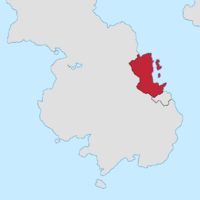Glestingsweald
This article is incomplete because it is pending further input from participants, or it is a work-in-progress by one author. Please comment on this article's talk page to share your input, comments and questions. Note: To contribute to this article, you may need to seek help from the author(s) of this page. |
Grand Duchy of Glestingsweald Gumrîce râd Glestingawolde (Glestisc) | |
|---|---|
Coat of arms
| |
| Motto: Āstand Fæt ge Blōw | |
 Glestingsweald in Southern Mesia | |
| Capital | Magoncaister |
| Largest city | Linnburh |
| Official languages | Glestisc |
| Recognised national languages | Jomðrigan Ilænisc Umbrisc |
| Demonym(s) | Glestisc |
| Government | Parliamentary Constitutional monarchy |
| Arlon II Foultun | |
| Morven Adkins | |
| Legislature | Witan |
| Bur of Brytan | |
| Bur of Ċeorlfolc | |
| Area | |
• Total | 497,322 km2 (192,017 sq mi) |
| Population | |
• 2019 estimate | 8,157,300 |
• Density | 168/km2 (435.1/sq mi) |
| HDI (2017) | 0.892 very high |
| Currency | Feoh (GWF) |
| Date format | DD-MM-YYY CE |
| Driving side | right |
| Internet TLD | .GWF |
The Grand Duchy of Glestingsweald, commonly called Glestingsweald or Glestingawolde, is a constitutional monarchy Southeastern Flrumleohema. It is bordered to the south by Ilæniswolde, and to the east by the Mesisc Strait. Glestingawolde covers 497,322 and has an estimated population of 8,157,300. The country comprises of ?? subdivisions with its capital in Magoncaister, located on the Cantware Peninsula in Southern Glestingawolde.
The country largely consists of flat alder glades, broken up by river valleys and temperate plains, that are home to Glestisc, Ilænisc, and Swabex populations. Located to the east are the hilly Jomðíeg Islands, home to the majority of Glestingawolde's Jomðrigan population. The majority of the population adheres to the Ceallīċ faith.
Etymology
This is an explanation of the origin of your nation's name.
History
Pre-Imperial Tribes
All prior to 500BCE
Sūdawealdh Colonialism
500BCE-690CE
Post-Imperial Tribes & Jomðrigan Migration
690CE-820CE
Formation of Glestingawolde
820CE-850CE
Grand Duchy of Glestingawolde
850CE-1790CE
Kærufinnas Tribute
1790CE-1820CE
Linnburh Revolution
1820CE-1940CE
Modern Period
1940CE-Present
